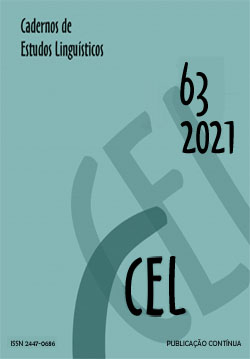Abstract
This paper aims to investigate the formal properties of the canonic cleft structures in Brazilian Portuguese (BP). Such sentences are used to focus syntactic constituents through A-bar movement and the presence of a copula and a complementizer in order to provide emphasis to the focalized constituent. The main aspect of the formal properties of the cleft sentences is the convergence possibilities between the verb ser (be) and another elements of the sentence in terms of agreement and tense. The canonic panorama in PB is the agreement of the copula with the focus and the tense harmony with the thematic verb. On the other hand, BP – but not European Portuguese (EP) – licenses cleft constructions without such convergences. This phenomenon led some authors to defend that, in this case, the copula was gramaticalized into a focus element, once it would figure in the invariable form é (is). We will provide evidences to postulate that there is no gramaticalization involving the copula of the clefts in BP and propose that the canonic cleft has always a verbal copula, that project an argument structure (IP), even when it appears to be invariable. The same is not observed in the é que-clefts ones, with the focus on the initial position of the sentence. This type of cleft would have a functional copula.
References
AMBAR, M. Clefts and tense asymmetries. In: DI SCIULLO A. M. (Ed.). UG and External Systems. Language, brain and computation. Amsterdam/Philadelphia: John Benjamins, 2005. p. 95-127.
BELLETTI, A. Revisiting the CP of clefts. In: GREWENDORF, G.; ZIMMERMANN, T. E. (Ed.). Discourse and Grammar - From Sentence Types to Lexical Categories. Berlin: Mouton de Gruyter, 2012. pp. 91-114.
CINQUE, G. Adverbs and Functional Heads: A Cross-linguistic Perspective. New York: Oxford University Press, 1999.
COSTA, J.; DUARTE, I. Minimizando a Estrutura: Uma Análise Unificada das Construções de Clivagem em Português. In: CORREIA, C.; GONÇALVES, A. (Ed.). Actas do XVI ENAPL. Lisboa: APL/Colibri, 2001. p. 627-638.
COSTA, J.; FIGUEIREDO SILVA, M. C. Nominal and verbal agreemend in Portuguese: An argument for Distributed Mophology. In: COSTA, J.; FIGUEIREDO SILVA, M. C. (Ed.). Studies on Agreement. Amsterdam: John Benjamins, 2006. p. 25-46.
HARTMANN, K.; VEENSTRA, T. Introduction. In: HARTMANN, K.; VEENSTRA, T. (Ed.). Cleft Structures. Amsterdam/Philadelphia: John Benjamins, 2013. p. 1-32.
KATO, M. A. Mudança de ordem e gramaticalização na evolução das estruturas de foco no português brasileiro. Estudos linguísticos, São Paulo, v. 38, n. 1, p. 375-385, jan./abr., 2009.
KATO, M. A. Estruturas de Focalização no português brasileiro dos séculos XIX e XX. In: CYRINO, S. M.; TORRES-MORAES, M. A. (Org.). Mudança sintática do português brasileiro: perspectiva gerativista. 1. ed. São Paulo: Contexto, 2018. p. 420-440.
KATO, M. A.; MIOTO, C. A multi-evidence study of European and Brazilian Wh-questions. In: KEPSER, S.; REIS, M. (Ed.). Linguistic evidence: theoretical, quantitative and computational perspectives. 1. ed. Berlin/New York: Mouton De Gruyter, 2005. p.307-328.
KATO, M. A.; M.; RIBEIRO, I. Cleft sentences from Old Portuguese to Modern Brazilian Portuguese. In: DUFTER, A.; JACOB, D. (Org.). Focus and Background in Romance Languages. Amsterdam: John Benjamins, 2009. p. 123-154.
LOBO, M. Assimetrias em construções de clivagem em português: movimento vs geração na base. In: OLIVEIRA, F.; BARBOSA, J. (Org.). Actas do XXI Encontro Nacional da Associação Portuguesa de Linguística. Lisboa: APL, 2006. p. 457 – 473.
MEILLET, A. L'évolution des formes grammaticales. Scientia (Rivista di Scienza), Paris, Librairie Ancienne Honoré Champion, 12, n. 26, 6, p. 130-148, 1912.
MIOTO, C.; FIGUEIREDO SILVA, M. C. Wh que = Wh é que? DELTA, v.11, n. 2, p. 301-311, 1995.
MODESTO, M. As construções clivadas no português do Brasil: relações entre interpretação focal, movimento sintático e prosódia. São Paulo: Humanitas / FFLCH / USP, 2001.
RIZZI, L. The Fine Structure of the Left Periphery. In: HAEGEMAN, L. (Ed.). Elements of Grammar: A Handbook of Generative Syntax. Dordrecht: Kluwer, 1997. p. 281-337.
RIBEIRO, Ilza. Construções de focalização: Comentários ao texto de Simone Guesser. In NAVES, Rozana Reigota; SALLES, Heloísa (Orgs). Estudos formais da gramática das línguas naturais. Goiânia: Cânone Editorial. 2011, p. 109-122.
ROBERTS, I. Diachronic Syntax. Cambridge: Cambridge University Press, 2007.
ROBERTS, I.; ROUSSOU, A. Syntactic Change. A Minimalist Approach to Grammaticalization. Cambridge: Cambridge University Press, 2003.
SILVEIRA, D. M. Clivadas e pseudo-clivadas na história do português: uma análise diacrônica das estruturas de foco e implicações da gramática V2. 2014. Dissertação (Mestrado em Linguística) – Unversidade Estadual de Campinas, Campinas, 2014.
SILVEIRA, D. M. A diacronia das clivadas e pseudo-clivadas: implicações da gramática V2 nas estruturas de foco. Cadernos de Estudos Linguísticos, Campinas, vol. 59, n. 2, p. 267-287, mai./ago. 2017.
SILVEIRA, D. M. Foco e Cartografia: Aspectos Formais das Estruturas Clivadas do Português Brasileiro. 2020. Tese (Doutorado em Linguística) – Universidade Federal de Santa Catarina, Florianópolis, 2020.
TESCARI NETO, A. Verb raising, the impoverishment of the verbal paradigm and the weakening of tense in BP. Revista do GEL, v. 13, p. 75-106, 2016.

This work is licensed under a Creative Commons Attribution-NonCommercial 4.0 International License.
Copyright (c) 2021 Cadernos de Estudos Linguísticos


